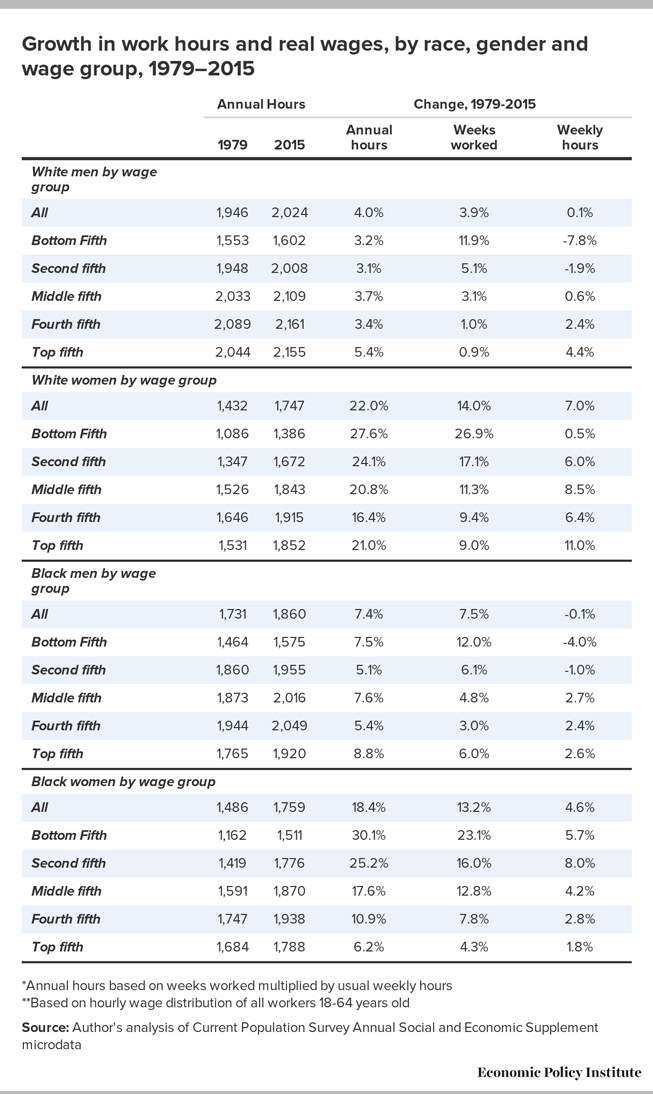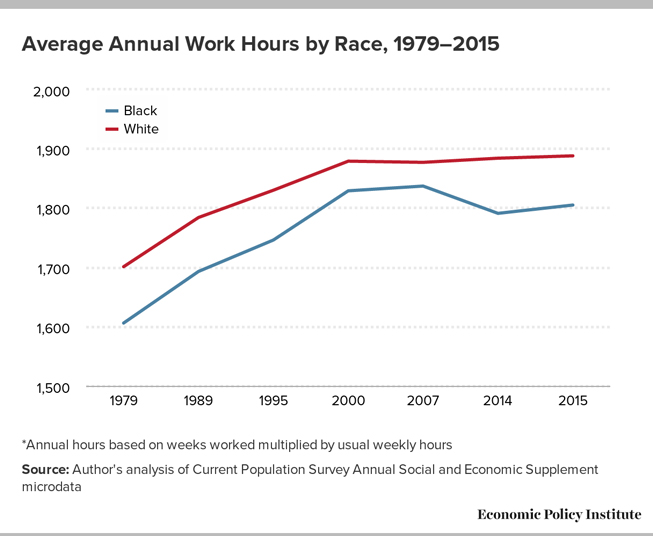Black women in particular bear the brunt of the burden.
By Valerie Wilson, Janelle Jones – Economic Policy Institute
Over the last several decades, black workers have been offering more to the economy and the labor market to incredibly disappointing results in pay and unemployment. Some have argued that the disparity in wages between blacks and white is the result of white workers working longer and harder than black workers. They blame black workers for racial wage gaps, saying that they should do anything from getting more education to simply working harder. Such explanations minimize the role of racial discrimination on labor market outcomes, while perpetuating racial bias and stereotypes of black workers as unmotivated and lazy.
And the data show they are simply false: hours and weeks worked have increased for both races, with a larger increase for black workers over the last several decades. The increase in annual hours is particularly striking for workers in the bottom 40 percent of the wage distribution, where it has been driven almost entirely by women.
Table 1 provides data on annual hours worked in 1979 and 2015 for workers ages 18–64 years old who report non-zero earnings during the year (so the averages are conditioned on working. In forthcoming research, we explicitly address trends in labor force participation). Work hours include paid vacations and time off, and therefore represent paid hours. The table also presents the percent change from 1979 to 2015 in annual hours, weeks worked, and weekly hours. These data are shown by race and wage fifth, or quintile.
The key finding is that the average black worker worked 1,805 hours in 2015, an increase of 199 hours, or 12.4 percent from the 1979 work year of 1,606 hours. Resulting in a smaller increase of 11.0 percent, the average white worker worked 1,888 hours in 2015, an increase of 187 hours from the 1979 work year of 1,701 hours. For both white and black workers, the growth in annual hours was primarily driven by an increase in the number of weeks worked (up 8.1 percent for white workers and 10.2 percent for black workers) rather than an increase in weekly work hours (up 2.7 percent for white workers and 2.0 percent for black workers). The increase in annual hours between 1979 and 2015 was more pronounced among workers in the lowest fifth of the wage distribution than among workers in the middle fifth. It was also greater among middle-wage workers than among the top fifth of earners.

As expected, the pattern for annual hours is similar to that of weeks. While the number of hours worked by those in the lowest quintile is consistently lower than those of better-off fifths, the greatest rise in weeks worked has been among individuals at the bottom of the income distribution. For both black and white workers, the growth in weeks worked for the bottom fifth was more than triple the increase for the top fifth. White workers in the bottom quintile have increased their annual hours by 17.0 percent since 1979, compared to 21.9 percent for black workers at the bottom. Annual hours for the second and middle fifth are very similar for black and white workers. At the top income distribution, white workers have seen a 5.6 percent increase in annual hours while black workers experienced a 6.2 percent increase.
Trends in work hours vary greatly by race, gender, and wage group. Table 2 provides data on annual hours, weeks worked, and weekly hours in 1979 and 2015, further disaggregated by these categories. The data reveal that growth in work hours, for both whites and blacks, was heavily driven by the growth of work hours among women. Overall annual work hours grew by 22.0 percent among white women and 18.4 percent among black women. However, the growth in annual hours in the bottom fifth and second fifth is larger for black women than for white women. Black women also have higher annual hours than white women all across the wage distribution.
Work hours only grew 4.0 percent among white men and 7.4 percent among black men. Similar to the overall trend, annual work hours grew more among women than among men from 1979 to 2015 because women increased their weeks per year more than their weekly hours in the paid workforce.


Figure A shows annual hours by race for the business cycle peak years of 1979, 1989, 2000, and 2007, as well as for 1995 (the point during the 1990s business cycle after which wages grew dramatically) and for 2014 and 2015 (the two most recent years of the current recovery for which data are available). It shows that this trend of African American workers increasing work hours more than their white counterparts occurred primarily between 1979 and 2000. With the exception of a notable decline in work hours among black workers between 2007 and 2014, work hours have changed very little since 2000. However, during this period of time, labor market returns to black workers continued to worsen relative to their white counterparts regardless of age, education, occupation, and other socioeconomic demographics.
The data make it clear that there has been no lack of effort on the part of black workers. Even in the face of persistent racial wage gaps, labor market discrimination, occupational segregation, and other labor market obstacles, black workers continue to increase their annual hours and weeks worked per year.
This blog post is based on data analysis from the EPI Program on Race, Ethnicity and the Economy’s (PREE) an ongoing project on Work Hours, Unemployment and Labor Market Disconnection.















